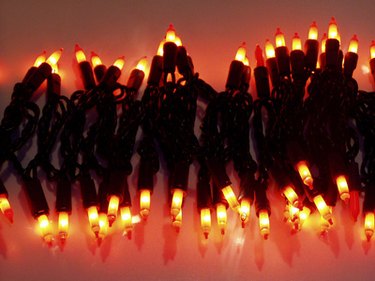
Using LED strands for your holiday lighting offers many benefits, including decreased energy usage and cooler bulbs, making them safer to use on Christmas trees. In addition, LED lights are more durable and last longer than incandescent lighting, but that doesn't mean that they will last forever. At some point, the lights may not work, and you may need to troubleshoot your LED light strands. Fortunately, this is an easy process that can extend the life of your lights.
Check the LED Strands Fuse
Video of the Day
The first thing to check if your lights aren't working is the fuse. Not all LED strands will have this, but many will have a small fuse box on the plug. Slide the plastic covering back to expose the fuse. If the fuse has blown, remove and replace it. Many light strings come with replacement fuses, or you can order them online or pick them up at your local hardware store. If the lights still aren't working after replacing the fuse, move on to check for bad bulbs.
Video of the Day
Look for Bad Bulbs
Bad bulbs and corrosion are common causes for a string of lights not working. This requires checking each bulb, which can be a bit tedious. Make sure you have replacement LED bulbs handy.
Starting at the plug, remove each LED light. Check the receptacle on the strand for any signs of corrosion. Use a brush to clean out the receptacle if necessary. Insert a new LED light and see if the strand works. If it does, you are all set. If not, examine the light you removed. Make sure that the two wires on the side of the light are both present and secure before replacing it. Ensure that each light is securely in place, as loose bulbs can also cause the string to stop working. Then, move on to the next light in the string.
You can also use a tool such as LED Keeper to check for bad bulbs. This is a much faster way to identify the bad bulb but keep in mind that the voltage checkers commonly used for incandescent bulbs will not work on LED strands. Make sure the bulb tester you select is designed to work with LEDs.
Replace Your LED Strands
While one big benefit of using LED lights is that they last for six years or more, there are some situations when you will need to replace your light strings. Some LED lights have a rectifier in the middle of the string. This is a component that helps to decrease light flickering. If the other troubleshooting methods don't work, it is possible that the rectifier is bad, and the string needs to be replaced.
If you notice that the wire is getting frayed or the insulation is cracked from where it was kinked or rubbing against something, it is safest to replace the string. Avoid pulling on the wires and make sure to store them neatly in a box so that nothing is crushing the lights. This helps to ensure your lights last longer and are ready to go when you need them.